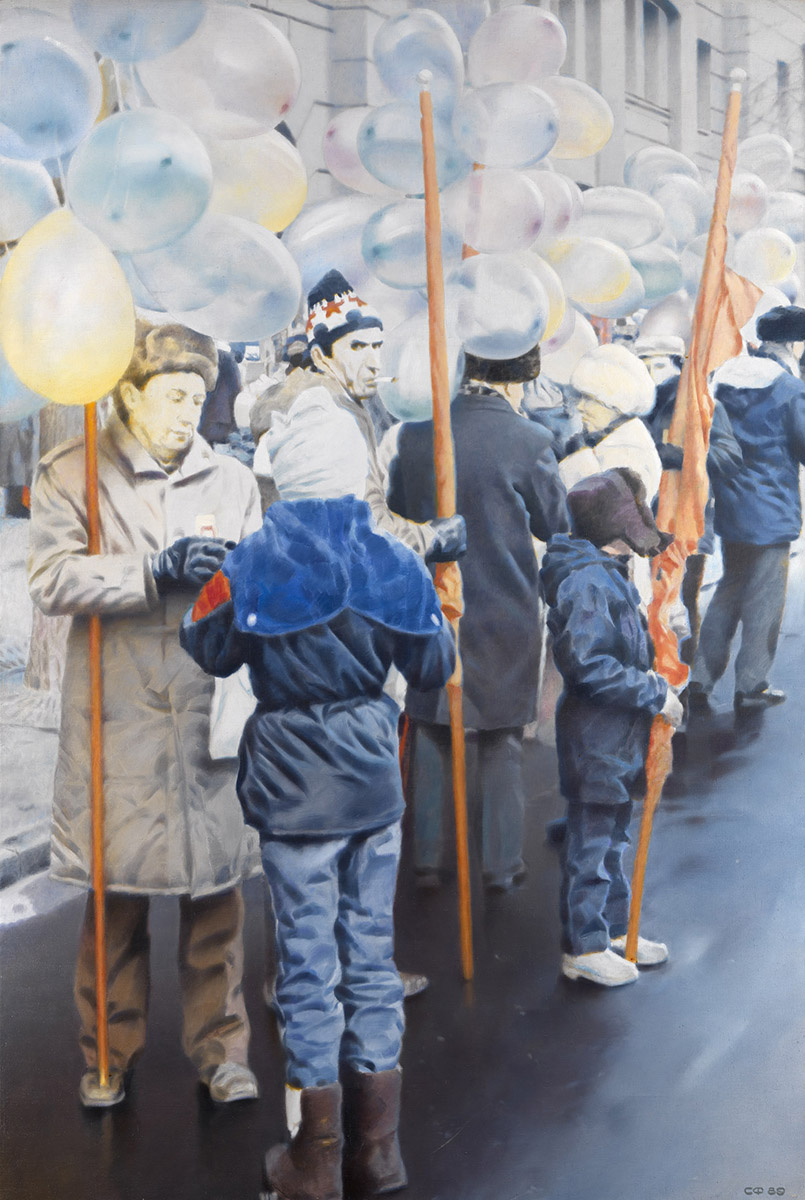MacDougall Auctions 2-3 December 2009
2 December 2009

* § 513. FAIBISOVICH, SEMION B. 1949
Assembly Point, from the series Celebratory Demonstration signed with initials and dated 1989, also further signed, titled in Cyrillic and dated on the reverse
Oil on canvas, 205 by 138 cm.
100,000-150,000 pounds
Provenance: Private collection, Europe.
Authenticity has been confirmed by the artist.
Related literature: For similar works, see Semen Faibisovich. Paintings from the 1980’s, Regina Gallery, Moscow, 2001, p. 96–97.
Assembly Point is one of ten pictures from the famous pictorial cycle The Festival, which was created by Faibisovich between 1986 and 1990 in parallel with other hyperrealistic projects on the theme of everyday Soviet realities (Scheduled Bus, Moscow Metro, Moscow Suburban Train, On the Beach, The Queue).
At first, the artist’s work was classified as photorealism, since from the technical point of view it was based on photography. However, it was not painstaking work with a camera as his starting point that interested Faibisovich so much as how to master it. The artist himself commented, “When I saw the work of Western photorealists for the first, time I was annoyed by the fact that I wasn’t the only one to use photos in my pictures. But then I realised it was different in my case: the important thing for them was the language, whereas for me it was the conversation, the thing that cannot be transmitted in the text and which you can only get by immersing yourself in communication. I consciously removed myself as an intermediary and left the viewer alone with what I had produced.” An architect by training, Faibisovich constructed his canvases as memorials to the vanishing world of the Soviet past, revealing the qualities of a hypnotist that are essential if one is to be able to stare long and intently into the surrounding reality. His canvases are a philosophical interpretation of reality which later, thanks to Vladimir Paperny, would be called “hypnorealism”.
Faibisovich painted Soviet people at parades on state festivals, in queues, in railway stations, in suburban trains, etc. The idea, which was developed in pictures of the Soviet celebrations of 1 May and in 7 November, came to the artist, as he himself admitted, when he was travelling to work by bus from the new Yasenevo district. “It was dreadful: it was a newly-built district, there was no metro and there was a savage crush every morning. But I suddenly realised that this picture excited me from the aesthetic point of view: there was beauty in those outrageous conditions, with the mass of people and the aloofness of their looks. When I thought about how to record it – after all, you can’t make a sketch – I took my primitive Zenit B camera, which I’d had since I was a student, and began taking photos. At first, when I started this series, I portrayed the looks of my fellow travellers staring somewhere into space, away from the viewer. There was such loneliness in the crowd. When people think that nobody’s watching them, something happens to them: they become isolated and sunk deep into themselves. It’s as if people are different, but they all have the same stamp. But then it became interesting to look into their eyes... I felt that I was on the edge; each session ended in some sort of half-crazy state. The look which grew from my brush was totally alive: suspicious, wary and full of hatred... towards an enemy. I created that look, and I was also at the receiving end.”
Assembly Point was created at the start of the 1990s, and in the artist’s works of this period the Moscow gallery-owner Yelena Selina notices a powerful charge of visuality and emotionality. Today, more than twenty years later, Faibisovich’s paintings have suddenly gained an almost glamorous expressiveness, with their enforced enlargement of the object to a size that blocks out any other reality.
A story is portrayed in the work presented at this auction, and the care with which the details and subjects are drawn makes the narration of this picture of the past all the more absorbing. In the “parades” and “queues” portrayed one can see above all the artist’s tenacious powers of observation that allow him, in his pictures, both to analyse a person’s internal life and to study the surrounding social landscape.
Notes on symbols:
* Indicates 5% Import Duty Charge applies.
Ω Indicates 20% Import Duty Charge applies.
§ Indicates Artist's Resale Right applies.
† Indicates Standard VAT scheme applies, and the rate of 20% VAT will be charged on both hammer price and premium.